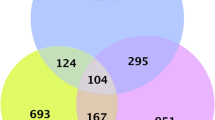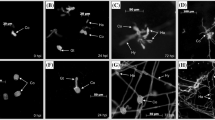Abstract
Phytophthora citricola is a wide spread and highly aggressive pathogen of Fagus sylvatica. The hemibiotrophic oomycete infects the roots and establishes a compatible interaction with F. sylvatica. To investigate the transcriptional changes associated with P. citricola infection, 68 custom oligo-microarray measurements were conducted. Hierarchical as well as non-hierarchical clustering was carried out to analyze the expression profiles. Experimental setup includes a time scale covering the biotrophic and necrotrophic stages of interaction as well as comparative analyses of the local and systemic responses. The local reaction of F. sylvatica is characterized by a striking lack of defense gene induction leading to the conclusion that P. citricola escapes the main recognition systems and/or suppresses the host's response. The analysis of the systemic reaction revealed a massive shift in gene expression patterns during the biotrophic phase that is interpreted as evidence of resource allocation into the roots to support the increased sink caused by pathogen growth. Defense genes known to be responsive to salicylic acid (effective against biotrophs), jasmonic acid, and ethylene (effective against necrotrophs and herbivores) are represented on the arrays. All significant changes in gene expression measured for salicylic acid responsive genes were down-regulations in roots and leaves while some jasmonic acid responsive genes showed a very late up-regulation only in leaves, probably caused by the desiccation shortly before plant death. Together, these expression changes could explain the success of the pathogen.




Similar content being viewed by others
Abbreviations
- CNB hypothesis:
-
Carbon nutrient balance hypothesis
- cRNA:
-
Complimentary RNA
- dpi:
-
Days post infection
- ET:
-
Ethylene
- hpi:
-
Hours post infection
- HR:
-
Hypersensitive response
- ISR:
-
Induced systemic resistance
- JA:
-
Jasmonic acid
- PCD:
-
Programmed cell death
- PR:
-
Pathogenesis related proteins
- SA:
-
Salicylic acid
- SAR:
-
Systemic acquired resistance
- SSH:
-
Suppression subtractive hybridization
References
Alfano JR, Collmer A (1996) Bacterial pathogens in plants: life up against the Wall. Plant Cell 8:1683–1698
Baum M, Bielau S, Rittner N, Schmid K, Eggelbusch K, Dahms M, Schlauersbach A, Tahedl H, Beier M, Guimil R, Scheffler M, Hermann C, Funk JM, Wixmerten A, Rebscher H, Honig M, Andreae C, Buchner D, Moschel E, Glathe A, Jager E, Thom M, Greil A, Bestvater F, Obermeier F, Burgmaier J, Thome K, Weichert S, Hein S, Binnewies T, Foitzik V, Muller M, Stahler CF, Stahler PF (2003) Validation of a novel, fully integrated and fexible microarray benchtop facility for gene expression profiling. Nucl Acids Res 31:e151
Bell JN, Ryder TB, Wingate VP, Bailey JA, Lamb CJ (1986) Differential accumulation of plant defense gene transcripts in a compatible and an incompatible plant-pathogen interaction. Mol Cell Biol 6:1615–1623
Birch PR, Rehmany AP, Pritchard L, Kamoun S, Beynon JL (2006) Trafficking arms: oomycete effectors enter host plant cells. Trends Microbiol 14:8–11
Box GEP, Cox DR (1964) An analysis of transformations. J Roy Stat Soc B 26:211–246
Brasier CM, Kirk SA (2001) Comparative aggressiveness of standard and variant hybrid alder Phytophthoras, Phytophthora cambivora and other Phytophthora species on bark of Alnus, Quercus and other woody hosts. Plant Pathol 50:218–229
Cooper AJ, Latunde-Dada AO, Woods-Tör A, Lynn J, Lucas JA, Crute IR, Holub EB (2008) Basic compatibility of Albugo candida in Arabidopsis thaliana and Brassica juncea causes broad-spectrum suppression of innate immunity. Mol Plant Microbe Interact 21:745–756
Cordelier S, de Ruffay P, Fritig B, Kauffmann S (2003) Biological and molecular comparison between localized and systemic acquired resistance induced in tobacco by a Phytophthora megasperma glycoprotein elicitin. Plant Mol Biol 51:109–118
Crepel C, Inghelbrecht S, Baeyen S, Maes M (2005) First report of leaf spots on Laurus nobilis caused by Phytophthora citricola in Belgium. Plant Disease 89:107–107
De Vos M, Van Oosten VR, Van Poecke RM, Van Pelt JA, Pozo MJ, Mueller MJ, Buchala AJ, Metraux JP, Van Loon LC, Dicke M, Pieterse CM (2005) Signal signature and transcriptome changes of Arabidopsis during pathogen and insect attack. Mol Plant Microbe Interact 18:923–937
Desender S, Andrivon D, Val F (2007) Activation of defence reactions in Solanaceae: where is the specificity? Cell Microbiol 9:21–30
Doares SH, Narvàez-Vàsquez J, Conconi A, Ryan CA (1995) Salicylic acid inhibits synthesis of proteinase inhibitors in tomato leaves induced by systemin and jasmonic acid. Plant Physiol 108:1741–1746
Enkerli K, Hahn MG, Mims CW (1997) Ultrastructure of compatible and incompatible interactions of soybean roots infected with the plant pathogenic oomycete Phytophthora sojae. Can J Bot 75:1493–1508
Flores T, Alape-Giron A, Flores-Diaz M, Flores HE (2002) Ocatin, a novel tuber storage protein from the Andean tuber crop oca with antibacterial and antifungal activities. Plant Physiol 128:1291–1302
Hu X, Bidney DL, Yalpani N, Duvick JP, Crasta O, Folkerts O, Lu G (2003) Overexpression of a gene encoding hydrogen peroxidegenerating oxalate oxidase evokes defense responses in sunflower. Plant Physiol 133:170–181
Jakobek JL, Smith JA, Lindgren PB (1993) Suppression of bean defense by Pseudomonas syringae. Plant Cell 5:57–63
Jiang RHY, Tripathy S, Govers F, Tyler BM (2008) RXLR effector reservoir in two Phytophthora species is dominated by a single rapidly evolving superfamily with more than 700 members. PNAS 105:4874–4879
Jung T (2009) Beech decline in Central Europe driven by the interaction between Phytophthora infections and climatic extremes. For Pathol 39:73–94
Jung T, Cooke DEL, Blaschke H, Duncan JM, Osswald W (1999) Phytophthora quercina sp nov., causing root rot of European oaks. Mycol Res 103:785–798
Jung T, Blaschke H, Osswald W (2000) Involvement of soilborne Phytophthora species in Central European oak decline and the effect of site factors on the disease. Plant Pathol 49:706–718
Kamoun S (2006) A catalogue of the effector secretome of plant pathogenic oomycetes. Annu Rev Phytopathol 44:41–60
Kanneganti T, Bai X, Win J, Meulia T, Goodin M, Kamoun S, Hogenhout SA (2007) A functional genetic assay for nuclear trafficking in plants. Plant J 50:149–158
Katsir L, Chung HS, Koo AJK, Howe GA (2008) Jasmonate signaling: a conserved mechanism of hormone sensing. Curr Opin Plant Biol 11:428–435
Keen NT, Yoshikawa M (1983) β-1,3-endoglucanase from soybean releases elicitor-active carbohydrates from fungal cell walls. Plant Physiol 71:460–465
Kogel K, Franken P, Hückelhoven R (2006) Endophyte or parasite - what decides? Curr Opin Plant Biol 9:358–363
Lambers H, Chapin FS, Pons TL (1998) Plant physiological ecology. Springer Verlag, New York
Lee H, Wang J, Tian L, Jiang H, Black M, Madlung A, Watson B, Lukens PJC, Wang J, Comai L, Osborn TC, Doerge RW, Chen J (2004) Sensitivity of 70-mer oligonucleotides and cDNAs for microarray analysis of gene expression in Arabidopsis and its related species. Plant Biotech J 2:45–57
Lehmann J, Atzorn R, Brückner C, Reinbothe S, Leopold J, Wasternack C, Parthier B (1995) Accumulation of jasmonate, abscisic acid, specific transcripts and proteins in osmotically stressed barley leaf segments. Planta 197:156–162
Liu X, Huang B, Lin J, Fei J, Chen Z, Pang Y, Sun X, Tang K (2006) A novel pathogenesis-related protein (SsPR10) from Solanum surattense with ribonucleolytic and antimicrobial activity is stress- and pathogen-inducible. J Plant Physiol 163:546–556
Marschner H (2003) Mineral nutrition of higher plants. Academic Press, London
Nishimura MT, Stein M, Hou BH, Vogel JP, Edwards H, Somerville SC (2003) Loss of a callose synthase results in salicylic acid-dependent disease resistance. Science 301:969–972
Norman-Setterblad C, Vidal S, Palva ET (2000) Interacting Signal Pathways Control Defense Gene Expression in Arabidopsis in Response to Cell Wall-Degrading Enzymes from Erwinia carotovora. Mol Plant Micr Interact 13:430–438
Palma K, Zhang Y, Li X (2005) An importin alpha homolog, MOS6, plays an important role in plant innate immunity. Curr Biol 15:1129–1135
Parniske M (2000) Intracellular accommodation of microbes by plants: a common developmental program for symbiosis and disease? Curr Opin Plant Biol 3:320–328
Peña-Cortés H, Albrecht T, Prat S, Weiler EW, Willmitzer L (1993) Aspirin prevents wound-induced gene expression in tomato leaves by blocking jasmonic acid biosynthesis. Planta 191:123–128
R-Development-Core-Team (2005) R: A language and environment for statistical computing. R Foundation for Statistical Computing, Vienna, Austria, http://www.R-project.org
Rinaldi C, Kohler A, Frey P, Duchaussoy F, Ningre N, Couloux A, Wincker P, Le Thiec D, Fluch S, Martin F, Duplessis S (2007) Transcript profiling of poplar leaves upon infection with compatible and incompatible strains of the foliar rust Melampsora larici-populina. Plant Physiol 144:347–366
Rosenzweig BA, Pine PS, Domon OE, Morris SM, Chen JJ, Sistare FD (2004) Dye-bias correction in dual-labeled cDNA microarray gene expression measurements. Environ Health Perspect 112:480–487
Saeed AI, Sharov V, White J, Li J, Liang W, Bhagabati N, Braisted J, Klapa M, Currier T, Thiagarajan M, Sturn A, Snuffin M, Rezantsev A, Popov D, Ryltsov A, Kostukovich E, Borisovsky I, Liu Z, Vinsavich A, Trush V, Quackenbush J (2003) TM4: a free, open-source system for microarray data management and analysis. Biotechniques 34:374–378
Schlink K (2009) Identification and characterization of differentially expressed genes from Fagus sylvatica roots after infection with Phytophthora citricola. Plant Cell Rep 28:873–882
Schubert R, Bahnweg G, Nechwatal J, Jung T, Cooke DEL, Duncan JM, Muller-Starck G, Langebartels C, Sandermann H, Osswald W (1999) Detection and quantification of Phytophthora species which are associated with root-rot diseases in European deciduous forests by species-specific polymerase chain reaction. Eur J For Pathol 29:169–188
Stamp N (2003) Out of the quagmire of plant defense hypotheses. Quart Rev Biol 78:23–55
Storey JD, Tibshirani R (2003) Statistical significance for genome-wide experiments. Proc Nat Acad Sci 100:9440–9445
Taoa Y, Xie Z, Chen W, Glazebrook J, ChangH-S HB, Zhu T, Zou G, Katagiri F (2003) Quantitative nature of Arabidopsis responses during compatible and incompatible interactions with the bacterial pathogen Pseudomonas syringae. Plant Cell 15:317–330
Thatcher LF, Anderson JP, Singh KB (2005) Plant defense responses: what have we learned from Arabidopsis? Functional Plant Biology 32:1–19
Thomann A, Dieterle M, Genschik P (2005) Plant CULLIN-based E3s: phytohormones come first. FEBS Lett 579:3239–3245
Tseng GC, Oh M, Rohlin L, Liao J, Wong WH (2001) Issues in cDNA microarray analysis: quality filtering, channel normalization, models of variations and assessment of gene effects. Nuc Acids Res 29:2549–2557
Werres S (1995) Influence of the Phytophthora isolate and the seed source on the development of beech (Fagus sylvatica) seedling blight. Eur J For Pathol 25:381–390
Win J, Morgan W, Bos J, Krasileva KV, Cano LM, Chaparro-Garcia A, Ammar R, Staskawicz BJ, Kamoun S (2007) Adaptive evolution has targeted the C-terminal domain of the RXLR effectors of plant pathogenic oomycetes. Plant Cell 19:2349–2369
Acknowledgements
I would like to thank Eliane Escher for excellent technical assistance. Advice in statistical analysis from Cristina-Maria Vâlcu and Mihai Vâlcu is gratefully acknowledged. I also thank the Editor-in-Chief Prof. Rudi Appels and two anonymous reviewers for helpful comments on the manuscript. This study was financially supported by the German Research Foundation (DFG) as part of the Collaborative Research Centre (SFB) 607 project A9.
Note added in proof
The Phytophthora isolate used in this study has just recently been identified to belong to the new species of Phytophthora plurivora sp. nov. (Jung T, Burgess TI (2009) Reevaluation of Phytophthora citricola isolates from multiple woody hosts in Europe and North America reveals a new species, Phytophthora plurivora sp. nov. Persoonia 22: 95–110).
Author information
Authors and Affiliations
Corresponding author
Electronic supplementary materials
Below is the link to the electronic supplementary material.
Supplementary Table 1
Array results for all genes with significant expression change in roots during the course of infection (in vitro infection) (XLS 745 kb)
Supplementary Table 2
Array results for all genes with significant expression change in leaves during the course of infection (in vitro infection) (XLS 850 kb)
Supplementary Table 3
Array results for all genes with significant expression change in leaves after soil infection (XLS 26.5 kb)
Rights and permissions
About this article
Cite this article
Schlink, K. Down-regulation of defense genes and resource allocation into infected roots as factors for compatibility between Fagus sylvatica and Phytophthora citricola . Funct Integr Genomics 10, 253–264 (2010). https://doi.org/10.1007/s10142-009-0143-x
Received:
Revised:
Accepted:
Published:
Issue Date:
DOI: https://doi.org/10.1007/s10142-009-0143-x




